Before completing this application, read the TSP booklet Loans to understand the features of the loan program, eligibility require- ments, and your responsibilities when you borrow from your TSP account. The booklet is available from your agency personnel of- fice, your service, or the TSP website (www.tsp.gov). Make a copy of this completed form for your records and mail the original form to the following address:
thrift savings Plan P.O. Box 385021 Birmingham, AL 35238
Or fax the form to 1-866-817-5023.
1–4: Information About You. Provide all the requested informa- tion. Your TSP account number is displayed on your participant statements.
5:Amount Requested. You may not borrow more than the to- tal amount that you contributed to the TSP and the earnings on that amount. You may not borrow less than $1,000 or more than $50,000. To determine the maximum amount you may borrow, you can visit the TSP website at www.tsp.gov or call the toll-free ThriftLine at 1-877-968-3778; TDD: 1-877-847-4385. Outside the U.S. and Canada, call 404-233-4400 (not toll free).
If you are not eligible to borrow the amount you requested, your Loan Agreement will be generated with the maximum amount you can borrow. Also, if you request a loan for less than $1,000, your loan amount will automatically become $1,000 as long as you have that amount available to borrow.
Note: Your loan will be disbursed proportionally from any tradition- al (non-Roth) and Roth balances in your account. Similarly, if you are a uniformed services employee with tax-exempt contributions in your account, your loan will contain a proportional amount from your tax-exempt contributions as well. Your loan payments will be deposited back into your account based on the same proportion(s) used at the time your loan was disbursed.
6:type and term of Loan. If you are requesting a general purpose loan, complete the requested information in Item a. If you are ap- plying for a residential loan, fill in the information requested in Item b. You can request a residential loan only for the purchase or construction of your primary residence.
•For a General Purpose Loan, the minimum time to repay is 1 year; the maximum time is 5 years. No documentation is required.
•For a Residential Loan, the minimum time to repay is
1 year; the maximum time is 15 years. Documentation of the amount will be required when you return your Loan Agreement. Do not send documentation for the amount of the loan with this form.
If you indicated in Item 6 a payment term of less than 1 year, your loan term will automatically be changed to a term of 1 year. If you indicated more than 5 years for a general purpose loan or more than 15 years for a residential loan, your term will be changed to the maximum term allowed for that type of loan.
7:Pay schedule. Loan payments are deducted from your pay each pay period. Make sure you indicate the correct pay schedule or your loan payments will be incorrect.
8–14: Information About Your spouse. If you are married (even if separated from your spouse), you must supply the requested in- formation about your spouse in Items 8 through 14. If your spouse has a foreign address, check the box in Item 10 and enter the for- eign address as follows:
First address line: Enter the street address or post office box number, and any apartment number.
Second address line: Enter the city or town name, other principal subdivision (e.g., province, state, county), and postal code, if known. (The postal code may precede the city or town.)
City/State/Zip Code fields: Enter the entire country name in the City field; leave the State and Zip Code fields blank.
If your spouse uses an Air/Army Post Ofice (APO) or Fleet Post Ofice (FPO) address, enter the address in the two available ad- dress lines (include the unit designation). Enter APO or FPO, as appropriate, in the City field. In the State field, enter AE as the state abbreviation for Zip Codes beginning with 090–098, AA for Zip Codes beginning with 340, and AP for Zip Codes beginning with 962–966. Then enter the appropriate Zip Code.
15: Notiication or consent of spouse not possible. The TSP must notify the spouse of a CSRS participant before a loan can be made. Spouses of FERS participants and of members of the uniformed services must consent to the loan by signing the Loan Agreement. Check Item 15 and provide your spouse’s Social Security number only if you are:
•FERS or are a member of the uniformed services and you cannot obtain your spouse’s signature because your spouse’s whereabouts are unknown or exceptional circumstances make it impossible to obtain your spouse’s signature, or
•CSRS and your spouse’s whereabouts are unknown.
You may be able to obtain an exception to these spousal rights requirements, but you must submit Form TSP-16, Exception to Spousal Requirements (TSP-U-16 for uniformed services). You are strongly encouraged to mail Form tsP-16/u-16 and sup- porting documentation with this Loan Application. You can ob- tain Form TSP-16/U-16 from the TSP website (www.tsp.gov) or from your agency or service.




 /
/